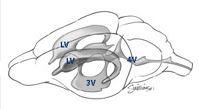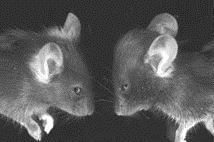Hydrocephalus in Laboratory Mice
By JAX® NOTES Issue 490, Summer 2003

Cerebrospinal fluid (CSF) is produced by the choroid plexus in the lateral and 4th ventricles in the brain (See Figure 1) and is similar in composition to serum, the fluid portion of the blood. CSF circulates throughout the ventricular system of the brain. This circulation is accomplished through the motion of the ciliated ependymal cells which line the ventricles. After circulating through the ventricles, the CSF then enters the cisterna magna at the base of the brain stem through the foramen of Magendie. From the cisterna magna, the CSF communicates with the meninges, the tissues surrounding the brain and spinal cord, and bathes the exterior of the brain. This subarachnoid CSF is absorbed into the systemic circulation through the arachnoid villi (also known as the arachnoid granulations).
*In hydrocephalus, the third ventricle and the lateral vetnricles are markedly enlarged, resulting in severe damage to the surrounding neural tissue.
Hydrocephalus may be caused by a blockage of the normal flow of CSF, a failure of absorption of CSF, or least commonly, an overproduction of CSF. Communicating hydrocephalus occurs when the flow of CSF is blocked after it exits the cerebral ventricles. Noncommunicating hydrocephalus occurs when there is a blockage rostral to the lateral apertures of the 4th ventricle or the mesencephalic aqueduct.

Clinical signs of hydrocephalus are readily apparent when young animals develop the disease before the cranial sutures close. The classic sign is an enlarged, domed head (Figure 2), accompanied by ataxia and depression. Damage to the neural tissue will result in the eventual death of the animal. The clinical signs of hydrocephalus are due to the fact that the brain is completely encased within the bony calvarium. Since there is no outlet for the pressure, the buildup of CSF causes pressure necrosis of the surrounding brain tissue and an enlargement of the ventricles, or, more rarely, a herniation of the brain. Hydrocephalic adult animals will not exhibit the domed skull, and the only finding may be an en-largement of the lateral ventricles, found at necropsy. In humans, hydrocephalus is associated with severe headache, vomiting, and other noxious symptoms. It is reasonable to assume that it is painful for animals as well. Since there is no effective treatment for hydrocephalus in mice, these mice should be euthanized when found.
**The mouse on the right has a rounded, enlarged cranium typical of hydrocephalus. When mice develop hydrocephalus after the cranial sutures have closed, no change in head shape will be observed.
Culling breeding pairs that produce hydrocephalic offspring may be useful in decreasing the incidence in a colony, but if the hydrocephalus is associated with a gene or phenotype of interest, this is impractical.
Congenital hydrocephalus is associated with some spontaneous mutations1-3, especially ones involving craniofacial morphology4, and some targeted mutations5 and transgenes6. Animals with defects in arachnoid villi may also present with hydrocephalus, since the defective villi are unable to move fluid effectively through the brain7. In addition, hydrocephalus is also seen as a background lesion in several strains of inbred mice. Defective development of the mesencephalic aqueduct or of the subarachnoid space has been observed in some of these cases8. In C57BL/6J mice, however, the cause is unknown. Hydrocephalus may also be acquired as a sequela to infections, such as with polyoma virus, reovirus, Theiler's murine encephalomyelitis virus, or lymphocytic choriomeningitis virus.
| Strain | Stock Number | Percent Hydrocephalus |
|---|---|---|
| C57BL/6J | 000664 | 0.02900% |
| B6.V-Lepob | 000632 | 0.03200% |
| C57BLKS/J | 000662 | 0.3600% |
| BKS.Cg-m +/+Lepdb | 000642 | 0.02800% |
| BALB/cJ | 000651 | 0.00023% |
| NOD/LtJ | 001976 | 0.00140% |
| NOD.CB17-Prkdcscid/J | 001303 | 0.00440% |
| BALB/cByJ | 001026 | 0.00075% |
| C3H/HeJ | 000659 | 0.00000% |
| SJL/J | 000686 | 0.00000% |
| DBA/2J | 000671 | 0.00330% |
references
References:
- Robinson ML, Allen CE, Davy BE, et al. Genetic mapping of an insertional hydrocephalus-inducing mutation allelic to hy3. Mamm Genome 2002; 13:625-632.
- Bronson RT, and Lane PW. Hydrocephalus with hop gait (hyh): a new mutation on Chromosome 7 in the mouse. Brain Res Dev Brain Res 1990; 54:131-136.
- Kume T., Deng KY, Winfrey V, et al. The forkhead/winged helix gene Mf1 is disrupted in the pleiotropic mouse mutation congenital hydrocephalus. Cell 1998; 93:985-996.
- Lyon MF, Quinney R, Glenister PH, et al. Doublefoot: a new mouse mutant affecting development of limbs and head. Genet Res 1996; 68:221-231.
- Rolf B, Kutsche M, and Bartsch U. Severe hydrocephalus in L1-deficient mice. Brain Res 2001; 891:247-252.
- Cohen AR, Leifer DW, Zechel M, et al. Characterization of a model of hydrocephalus in transgenic mice. J Neurosurg 1999; 91:978-988.
- Ibanez-Tallon I., Gorokhova S, and Heintz N. Loss of function of axonemal dynein Mdnah5 causes primary ciliary dyskinesia and hydrocephalus. Hum Mol Genet 2002; 11:715-721.
- Bruni J E, Del Bigio MR, Cardoso ER, et al. Hereditary hydrocephalus in laboratory animals and humans. Exp Pathol 1988; 35:239-246.